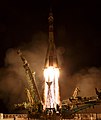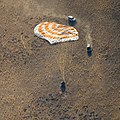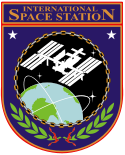Sojus MS-12
| Missionsdaten | |||
|---|---|---|---|
| Mission | Sojus MS-12 | ||
| NSSDCA ID | 2019-013A | ||
| Raumfahrzeug | Sojus 7K-MS (GRAU-Index 11F732) Seriennummer 742 | ||
| Rufzeichen | Бурла́к („Burlak“) | ||
| Trägerrakete | Sojus FG (GRAU-Index 11A511FG) | ||
| Besatzung | 3 | ||
| Start | 14. März 2019, 19:14 UTC | ||
| Startplatz | Baikonur 1/5 | ||
| Raumstation | ISS | ||
| Andockplatz | Rasswet | ||
| Ankopplung | 15. März 2019, 01:01 UTC | ||
| Abkopplung | 3. Oktober 2019, 07:37 UTC | ||
| Dauer auf ISS | 202d 6h 36min | ||
| Landung | 3. Oktober 2019, 10:59 UTC | ||
| Landeplatz | 150 km OSO von Schesqasghan, 47° 24′ N, 69° 34′ O | ||
| Flugdauer | 202d 15h 45min | ||
| Erdumkreisungen | 3248 | ||
| Mannschaftsfoto | |||
 Christina Hammock Koch, Alexei Owtschinin und Nick Hague | |||
| ◄ Vorher / nachher ► | |||
| |||
Sojus MS-12 war ein Flug des russischen Raumschiffs Sojus zur Internationalen Raumstation. Im Rahmen des ISS-Programms trägt der Flug die Bezeichnung ISS AF-58S. Es war der 58. Besuch eines Sojus-Raumschiffs an der ISS und der 164. Flug im Sojusprogramm.
Besatzung
Hinflug
Hauptbesatzung
- Alexei Nikolajewitsch Owtschinin (2. Raumflug), Kommandant (Russland/Roskosmos)
- Tyler N. Hague (1. Raumflug), Bordingenieur (USA/NASA)
- Christina Hammock Koch (1. Raumflug), Bordingenieurin (USA/NASA)
Ursprünglich war geplant, dass ein Raumfahrer der Vereinigten Arabischen Emirate mit an Bord sein sollte.[1][2] Der Rückflug sollte mit dem Raumschiff Sojus MS-10 erfolgen, das nach sechs Monaten Aufenthalt an der ISS zur Erde zurückgekehrt wäre. Da Sojus MS-10 aber nach einem Fehlstart nicht zur ISS gelangte, fehlte diese Rückkehrmöglichkeit, so dass der erste Raumflug eines Astronauten aus den Emiraten auf den Flug Sojus MS-15 verschoben werden musste.[3]
Auch der ursprünglich für diesen Flug geplante Kosmonaut Oleg Iwanowitsch Skripotschka wurde zugunsten eines erneuten Starts der Sojus-MS-10-Raumfahrer aus der Besatzung genommen.
Ersatzmannschaft
Unter normalen Umständen wäre die geplanten Besatzung von Sojus MS-15 als Ersatzmannschaft für den Flug MS-12 zum Zuge gekommen. Wegen des Mitflugs des Kurzzeitbesuchers aus den Emiraten waren für MS-15 aber nur zwei Langzeitexpeditionsmitglieder vorgesehen. So wurde für MS-12 nochmals die Ersatzmannschaft von Sojus MS-11 aufgestellt:
- Alexander Alexandrowitsch Skworzow (3. Raumflug), Kommandant (Russland/Roskosmos)
- Luca Parmitano (2. Raumflug), Bordingenieur (Italien/ESA)
- Andrew Morgan (1. Raumflug), Bordingenieur (USA/NASA)
Alle drei flogen dann mit der nachfolgenden Mission Sojus MS-13 zur ISS.
Rückflug
- Alexei Nikolajewitsch Owtschinin
- Tyler N. Hague
- Hassa al-Mansuri
Missionsbeschreibung
Sojus MS-12 brachte zwei Besatzungsmitglieder der ISS-Expeditionen 59 und 60 (Owtschinin und Hague) und eines für die Expeditionen 59 bis 61 (Koch) zur Raumstation. Das Schiff dockte planmäßig im „Express-Modus“, das heißt nach sechs Stunden und vier Erdumläufen, am Rasswet-Modul der ISS an.
Nach gut 202 Tagen Aufenthalt koppelte das Raumschiff am 3. Oktober 2019 wieder von der Station ab. Statt Christina Koch, die auch an der ISS-Expedition 61 teilnahm und damit einen neuen Rekord für den längsten Aufenthalt einer Frau im Weltraum aufstellte, kehrte Hassa al-Mansuri nach einer Woche ISS-Aufenthaltsdauer mit Sojus MS-12 zurück. Die Raumkapsel landete etwa 150 Kilometer ostsüdöstlich von Schesqasghan in der Kasachensteppe und kippte dabei auf die Seite. Die Crew konnte wohlbehalten geborgen werden.
Galerie
Sojus MS-12 von Cupola aus gesehen
Siehe auch
- Liste der bemannten Raumflüge
- Liste der bemannten Missionen zur Internationalen Raumstation
- Liste der Sojus-Missionen
Weblinks
- Sojus MS-12 im NSSDCA Master Catalog (englisch)
- Sojus MS-12 bei spacefacts.de
- Sojus MS-12 im Russian Space Web
Einzelnachweise
- ↑ James Langton: Sheikh Mohammed: First UAE astronaut is heading to the stars next year. The National, 20. Juni 2018, abgerufen am 25. Juni 2018 (englisch).
- ↑ Arabian Business: Revealed: the first Emirati astronauts to go into space. 3. September 2018, abgerufen am 4. September 2018 (englisch): „One of them will be joining a crew of Russian commander and an American astronaut in Soyuz MS-12 spaceflight which is planned to launch to ISS in April 2019“
- ↑ TASS: UAE astronaut not to fly to ISS in April after accident with Soyuz MS-10. 14. Oktober 2018, abgerufen am 13. Oktober 2018 (englisch).
Auf dieser Seite verwendete Medien
The Soyuz MS-12 spacecraft is seen as it lands in a remote area near the town of Zhezkazgan, Kazakhstan with Expedition 60 crew members Nick Hague of NASA and Alexey Ovchinin of Roscosmos, along with visiting astronaut Hazzaa Ali Almansoori of the United Arab Emirates, Thursday, Oct. 3, 2019. Hague and Ovchinin are returning after 203 days in space where they served as members of the Expedition 59 and 60 crews onboard the International Space Station. Almansoori logged 8 days in space during his first flight as an astronaut.
Backdropped by a blanket of clouds, the Soyuz TMA-7 spacecraft departs from the International Space Station carrying astronaut William S. (Bill) McArthur Jr., Expedition 12 commander and NASA space station science officer; Russian Federal Space Agency cosmonaut Valery I. Tokarev, flight engineer; and Brazilian Space Agency astronaut Marcos C. Pontes. Undocking occurred at 2:48 p.m. (CDT) on April 8.
View of Earth taken during ISS Expedition 58.
Visiting astronaut Hazzaa Ali Almansoori of the United Arab Emirates, left, Expedition 60 crewmembers Alexey Ovchinin of Roscosmos, center, and Nick Hague of NASA sit in chairs outside the Soyuz MS-12 spacecraft after they landed in a remote area near the town of Zhezkazgan, Kazakhstan on Thursday, Oct. 3, 2019. Hague and Ovchinin are returning after 203 days in space where they served as members of the Expedition 59 and 60 crews onboard the International Space Station. Almansoori logged 8 days in space during his first flight as an astronaut.
The Soyuz MS-12 spacecraft that launched three new Expedition 59-60 crew members to the International Space Station is pictured docked to the Rassvet module. Cosmonaut Alexey Ovchinin from Roscosmos commanded the Soyuz crew ship flanked by NASA astronauts Nick Hague and Christina Koch during the five-hour, 47-minute trip that began at the Baikonur Cosmodrome in Kazakhstan.
The Soyuz MS-12 spacecraft is launched with Expedition 59 crewmembers Nick Hague and Christina Koch of NASA, along with Alexey Ovchinin of Roscosmos, Friday March 15, 2019, Kazakh time (March 14 Eastern time) at the Baikonur Cosmodrome in Kazakhstan. Hague, Koch, and Ovchinin will spend six-and-a-half months living and working aboard the International Space Station.
At the Baikonur Cosmodrome in Kazakhstan, Expedition 59 crew members Christina Koch of NASA (left), Alexey Ovchinin of Roscosmos (center) and Nick Hague of NASA (right) pose for pictures in front of their Soyuz MS-12 spacecraft Feb. 27 during pre-launch training. They will launch March 14, U.S. time, on the Soyuz MS-12 spacecraft from the Baikonur Cosmodrome in Kazakhstan for a six-and-a-half month mission on the International Space Station.
The Soyuz rocket is transported by train to the launch pad, Tuesday, March 12, 2019 at the Baikonur Cosmodrome in Kazakhstan. Expedition 59 crewmembers Nick Hague and Christina Koch of NASA, along with Alexey Ovchinin of Roscosmos, will launch March 14, U.S. time, on the Soyuz MS-12 spacecraft from the Baikonur Cosmodrome for a six-and-a-half month mission on the International Space Station.
















